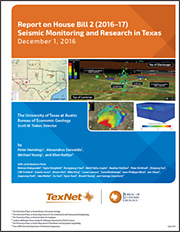The Bureau of Economic Geology’s Center for Integrated Seismicity Research (CISR) and the Stanford Center for Induced and Triggered Seismicity (SCITS) are soliciting cooperative research with petroleum operators in the Ft. Worth Basin (FWB) region to improve integrated studies on the nature and controls on seismicity in the basin that may be associated with oil and gas operations. The North Texas Seismicity Study Group at SMU and the Texas A&M Petroleum Engineering Department are also important partners within this collaboration. We propose to form a series of cooperative research projects between our institutional centers and cooperating companies to facilitate geological, geophysical, and engineering analyses and modeling of conditions and processes as pertaining to fault reactivation and resulting seismicity. We are pursuing 7 project areas (tasks) that, when properly combined, will provide a mechanistic understanding of seismicity in the FWB that can inform mitigation strategies. The goal of this partnership is to maximize the leveraging of efforts undertaken by both groups to avoid duplication of research and improve the understanding of data obtained by industry.
Tasks, data requirements, and lead individuals/groups:
- Crustal stress state. Mark Zoback’s group in SCITS has been developing a detailed analysis of the state of crustal stress across Texas and in the FWB area, including stress orientation and magnitude. The stress interpretation will be assessed in conjunction with basin-scale models developed by CISR. Petroleum operators can greatly facilitate this task by making available wellbore petrophysical, core and leak-off/formation integrity data for geomechanical analysis.
- Fault interpretation. Peter Hennings and Chris Zahm of the CISR group will work with Beatrice Magnani and others from SMU to compile a detailed interpretation of faults in and around the FWB, build 3D models of the principal faults, and conduct an analysis of the geometry, growth history, linkage systematics, and fault population characteristics in both the sedimentary section and into basement as data allows. The success of this task relies on operators making their 2D and 3D seismic data or seismic interpretations available for further study.
- Geomodel, fluid flow data, and pore pressure analysis. Led by JP Nicot and Bridget Scanlon, the BEG’s Hydrogeology group will build and maintain fluid budget data for the basin. The BEG’s Robin Dommisse working with the BEG’s Shale Resources group and other CISR researchers will develop a geocellular model of the FWB that will be used for input into reservoir and geomechanical modeling analyses and will include the effect of faults and other classes of heterogeneity. CISR’s Jon Olson, using the FWB geomodel, will build regional-scale reservoir engineering models to estimate pore pressure evolution and volumetric connectivity. This work will be done in conjunction with Matt Hornbach of SMU and Steve Gorelick at Stanford. Data needed for this task include reservoir and/or wellhead shut-in pressure, petrophysical data, porosity and permeability data, and modeling grids.
- Seismicity studies. SMU, in part funded by CISR, is leading the study of seismicity in the FWB to determine earthquake locations and depths, calibrated magnitudes, focal mechanisms, fault imaging, and cataloging. Alexandros Savvaidis at BEG is leading the deployment of TexNet permanent and transportable stations and data from this network will be used as it becomes available in late 2016, in conjunction with existing seismometer stations in the area. Heather DeShon and Brian Stump of SMU have been working with Stanford’s Bill Ellsworth on characterization of the earthquakes occurring in the basin, including precision locations, focal mechanisms and source parameters. Microseismic data collected during hydraulic fracturing operations would be of particular value to the seismicity studies. Stanford’s Greg Beroza has been developing new techniques for the rapid identification of extremely small earthquakes previously hidden by noise that can be used to extract additional information from existing data sources. New velocity models for the FWB and other areas of Texas will be developed to improve the performance of local and regional seismic arrays. Industry-provided check-shot and digitized sonic log data would be very helpful in supporting this task.
- Deterministic and stochastic assessment of fault reactivation potential. The CISR, SMU and Stanford groups will use the results of tasks 1-4 to assess fault reactivation potential, casting the results in terms of pore pressure required for slip, including an uncertainty treatment. The SCITS group, in partnership with XTO/XOM, is developing a Fault Slip Potential modeling tool and will use it, along with the results of tasks 1-5, to assess the risk of fault reactivation volumetrically throughout the FWB.
- Computational assessment of fault reactivation potential. CISR researchers Peter Eichhubl and Jon Olson will conduct site-specific geomechanical modeling projects designed to quantify the geomechanical conditions and mechanisms that are required to cause fault rupture. Fault rupture size and permeability feedback will also be investigated. Texas A&M researchers Akhil Datta-Gupta, Jihoon Kim and Michael King will conduct site-specific coupled fluid flow and geomechanical modeling to examine fault activation and induced seismicity in the vicinity of Azle. Geomechanical models developed by Paul Segall’s and Roland Horne’s groups at Stanford can also contribute to the broader questions of conditions favoring fault reactivation throughout the basin.
- Development of a basin-wide seismicity potential model. Using the results of tasks 1-6, CISR’s Ellen Rathje and Stanford’s Jack Baker will develop Probabilistic Seismic Hazard Assessments for the FWB based on well-established principles of PSHA that combine earthquake hazard, ground motion prediction, earthquake probability, and the vulnerability of structures in the area. Near-surface shear velocity data is critical in assessing ground acceleration therefore CISR’s Brady Cox will collect Vs30 measurements in the FWB and throughout Texas.
Time Line

